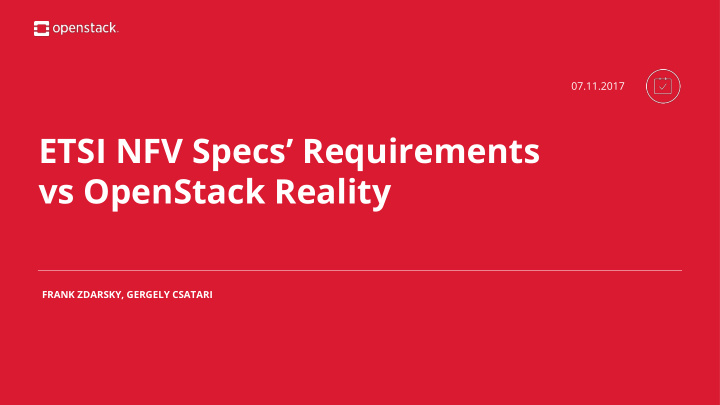



07.11.2017 ETSI NFV Specs’ Requirements vs OpenStack Reality FRANK ZDARSKY, GERGELY CSATARI
NFV? Network Functions Virtualization? • Business transformation of telco industry from mainframe era to cloud era physical network appliance
The Trigger: ETSI NFV • NFV community with broadest telco stakeholder representation • operators, vendors, regulators, ... • hosted by European Telco Standards Institute (ETSI) • end-to-end system view • goals: • create industry momentum for NFV • coordinate standardization orgs, not to become one. That failed.
Typical (Telco) Standards Methodology • “3 stage” waterfall model • implementation-agnostic Stage 1: Use Cases & Requirements • standards-first Stage 2: • validation through Architecture & Info Models reference implementations Stage 3: and vendor feedback Protocols/APIs and data models • IPR under FRAND
& Standards vs Open Source • One API to rule them all? • How to close gaps? Foster interop? • OPNFV: integration, testing, filling gaps upstream, implementer feedback • ETSI: focus on what+why vs how • “Open Source Work Item” (TST003) • awareness & connecting communities • facilitating feedback into ETSI NFV • analysing OpenStack gaps vs ETSI NFV
Our work approach Functional comparison of ETSI specs (IFA005/IFA006) with OpenStack APIs • Steps: • API level comparison in a Google spreadsheet 1. Collection of potential gaps, user stories and inconsistencies in an ETSI internal wiki 2. Show the findings to ETSI NFV in form of contributions 3. Provide fixes to the ETSI NFV specifications in form of contributions 4. Publish the gaps in a public NFV wiki (https://goo.gl/W3VQGv) 5. “Translate” the gaps to OpenStack terminology ( http://goo.gl/tGEJRW) 6.
OpenStack projects ETSI NFV IFA005/IFA006 tc:approved-release V2.1.1 Ocata 3 2 1 IFA005/IFA006 OpenStack gaps inconsistencies or bugs IFA005/IFA006 features without proper user story
Gap analyzis Outcomes 14 inconsistencies identified from which 8 TST and IFA contribution created 33 user story identified from which 47 TST and IFA contributions created 22 gaps in OpenStack have been identified
TST003 Outcomes Gaaaaps, what gaps? (some explanation and some examples) Telco workloads are different from IT in a sense that the workload is more predictable, there is less spare capacity in the system. There are latency requirements directly derived from physics while 911 must always go through . These networks are extremely big and difficult and managed by complex systems . Therefore There is a need for resource reservation possibility for predictable critical workloads. Usage of hardware acceleration , direct access to hardware devices or avoiding of process migration is needed. As the management systems would like to have a complete resource inventory of the several VNF-s and cloud instances a pub-sub model is preferred instead of polling all resources all the time. And so on Detailed session about some selected gaps is on Wednesday from 9:50 at C4.9 .
Okay, what now?
Next steps • In the workshop during the Denver PTG OpenStack representatives requested • a better description of the gaps • a clear user story for the gaps • a priority order of the gaps
Next steps • Have a consensus on the gaps • Detailed specification of the gaps • Implementation of the gaps irc:csatari | mailto:gergely.csatari@nokia.com
THANKS. Questions? openstack @OpenStack openstack OpenStackFoundation
Recommend
More recommend